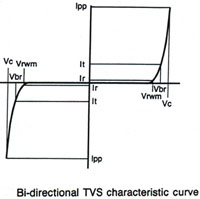Transient Voltage Suppressors (TVS) are semiconductor devices designed to provide protection against voltage and current transients. The silicon TVS is designed to operate in the avalanche mode and uses a large junction area to absorb large transient currents. Operation in the avalanche mode insures a low impedance; also the TVS is characterized by a fast response time. The TVS is available as unipolar or bipolar (that is it can suppress transients in one direction or in both directions).
The typical characteristic curve for a bipolar TVS is shown below:

Referring to the curve:
The breakdown voltage (Vbr) is the point the TVS device enters avalanche, a high conductance region. This Vbr is measured at test current It. A circuit with a TVS protection would obviously operate below the voltage, Vrwm, also referred to as the working voltage. Ir is the maximum current measured at the working voltage. The maximum peak pulse current for a TVS is Ipp. The maximum clamping voltage, Vc, is the maximum voltage across the TVS when it is subjected to Ipp.


Leave A Comment